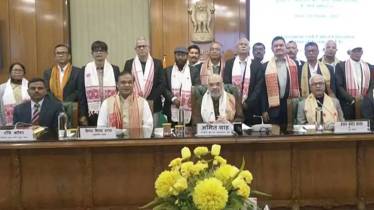By Prakash Katoch
ULFA: The Mirage of Dawn
Rajeev Bhattacharyya,
HarperCollins
Pp 400, Rs 599
Exhaustive research and interviews with the apex hierarchy of ULFA come together in ten smooth-flowing chapters in this book tracing the bloody history of ULFA.
Beginning with what has been plaguing Assam since before it became part of India, the book includes issues of illegal immigration and resource exploitation during Burmese occupation under British rule and even after independence, unemployment, corruption in governments and officials, inept administration, Centre and state vote-bank policies like grant of scheduled caste status to some classes just before the 2019 general elections.
The extraordinary efforts put in by the author to meet and interview Paresh Baruah, Arabinda Rajkhowa and Anup Chetia of the apex ULFA hierarchy in addition to many others is very commendable.
The detailed description of ULFA includes its spread into Myanmar, Bangladesh and Bhutan. This, along with efforts by Paresh Baruah to arm, train and expand the organisation in conjunction with contacts in Bangladesh, Pakistan and China, as also its protracted association with the NSCN (K) and attempts to form a coalition with other northeast militant organisations, can be a model study on how youth take to militancy and militant-cum-terror organisations are formed. ULFA’s consolidation in Bangladesh during the BNP-led rule and the role of the ISI are described well.
The feud between the Baruah-headed military wing and the political wing headed by Rajkhowa in ULFA, absence of long-term strategy and disorderly recruitment of cadres have been identified by the author as the major reasons leading to the split of the organisation, surrender by cadres and formation of SULFA. The author has also pointed out the follies of ULFA, including incidents like the abduction and disappearance of Sujoi Ghose, who ran an NGO, and the blast at a school in Dhemaji killing ten children and injuring 28, besides some other incidents that were viewed adversely by the public.
Acknowledging the army had zero cooperation from Assam Police and the state government in Operation Bajrang, the book says the army indulged in brutalities every day. Chapter three also says that army personnel cannot be charged or prosecuted because of the Armed Forces Special Powers Act (AFSPA), which is refuted in later chapters by detailing sentences awarded to army personnel. Understandably, the author is speaking the language of militants-terrorists who hate the army. The description of ‘killer squads’ of security forces and SULFA does not name any police officer either. Obviously, any journalist/author would need to keep ULFA and the police on the right side given their past violent history.
The book describes in detail the four failed peace talks earlier because of multiple reasons, the main one being ULFA’s demand for sovereignty. The book concluded before the Union government claimed to have inked a deal with ULFA on December 29 last year. However, the author rightfully points out that any peace deal would be contingent upon the sincerity with which it is executed on ground to resolve the problems of Assam. The following are of special interest: one, Pakistan’s ISI continues to have considerable influence in Bangladesh, despite the Awami League government, through contacts with DGFI and intelligence agencies; two, elements of northeast militants (less ULFA) remain untouched in Bangladesh and even some ULFA elements are back in Bangladesh; three, the US had contacted ULFA in Dhaka; four, ULFA and other northeast militants suffered a setback during joint India-Myanmar army operations Sunrise I and II. However, under the present military-junta rule in Myanmar, these organisations are left free; five, Himanta Biswa Sarma, chief minister of Assam, was arrested in 2019 for alleged links with ULFA; six, following the rout from Bhutan-Bangladesh, surrenders and pro-peace factions, ULFA is down but not out, with some 300-plus cadres in Myanmar alone and Paresh Baruah shuttling between Ruili in Yunnan and Myanmar.
The peace deal with ULFA, which the government signed on December 29, is akin to a similar peace deal signed with UNLF a month earlier—both perhaps political expediencies in the run-up to elections. Two days after the latter claim, a press release by the central committee of UNLF said this was a deal only to hold talks and not a peace deal, and that, too, with a breakaway group of UNLF. In case of ULFA, Paresh Baruah has expressed willingness to discuss peace if the issue of sovereignty is discussed, which will remain the Catch-22.
With certainty of the BJP retaining power this year, the Centre will allocate enormous funds to Assam, but how much of these will address Assam’s multiple woes will be the key. The author surmises that the Assam Accord of 1985 will be dead with implementation of the Citizenship Amendment Act (CAA). How would the public react to the CAA killing the Assam Accord? Being an outspoken proponent of hardcore Hindutva, will Sarma resort to ethnic cleansing, as is happening in neighbouring Manipur, and how would that impact the population?
The book is immensely relevant to the changing dynamics of the northeast; Myanmar-based terrorist outfits operating in Manipur amid the deteriorating situation, large influx of immigrants from Myanmar into Mizoram and Manipur, the newly-elected chief minister of Mizoram telling the Prime Minister that fencing of the border with Myanmar is not acceptable, and the like. Beijing’s lien on northeast militant organisations must not be neglected under the utopian view that China will ‘only’ resort to nibbling our territory.
Keeping all the above issues in mind, this book written in simple language is recommended to be read by all those interested in the evolution and nature of militancy in Assam, future portends of Assam and the northeast and how it impacts India’s national security.
However, footnotes, though numbered, are missing. Correlating the footnotes with the narrative would have made the reading that much more interesting.
Lt Gen Prakash Katoch (retired) is an Army veteran
